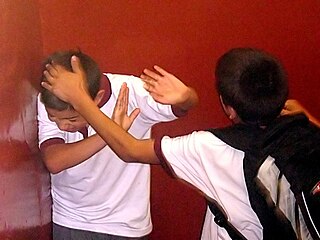
In sociology, a peer group is both a social group and a primary group of people who have similar interests (homophily), age, background, or social status. The members of this group are likely to influence the person's beliefs and behaviour.

Bullying is the use of force, coercion, hurtful teasing or threat, to abuse, aggressively dominate or intimidate. The behavior is often repeated and habitual. One essential prerequisite is the perception of an imbalance of physical or social power. This imbalance distinguishes bullying from conflict. Bullying is a subcategory of aggressive behavior characterized by hostile intent, imbalance of power and repetition over a period of time.
In psychology, an attribution bias or attributional errors is a cognitive bias that refers to the systematic errors made when people evaluate or try to find reasons for their own and others' behaviors. It refers to the systematic patterns of deviation from norm or rationality in judgment, often leading to perceptual distortions, inaccurate assessments, or illogical interpretations of events and behaviors.
School violence includes violence between school students as well as attacks by students on school staff and attacks by school staff on students. It encompasses physical violence, including student-on-student fighting, corporal punishment; psychological violence such as verbal abuse, and sexual violence, including rape and sexual harassment. It includes many forms of bullying and carrying weapons to school. The one or more perpetrators typically have more physical, social, and/or psychological power than the victim. It is a widely accepted serious societal problem in recent decades in many countries, especially where weapons such as guns or knives are involved.
Relational aggression, alternative aggression, or relational bullying is a type of aggression in which harm is caused by damaging someone's relationships or social status.

Social rejection occurs when an individual is deliberately excluded from a social relationship or social interaction. The topic includes interpersonal rejection, romantic rejection, and familial estrangement. A person can be rejected or shunned by individuals or an entire group of people. Furthermore, rejection can be either active by bullying, teasing, or ridiculing, or passive by ignoring a person, or giving the "silent treatment". The experience of being rejected is subjective for the recipient, and it can be perceived when it is not actually present. The word "ostracism" is also commonly used to denote a process of social exclusion.
Verbal abuse is a type of psychological/mental abuse that involves the use of oral, gestured, and written language directed to a victim. Verbal abuse can include the act of harassing, labeling, insulting, scolding, rebuking, or excessive yelling towards an individual. It can also include the use of derogatory terms, the delivery of statements intended to frighten, humiliate, denigrate, or belittle a person. These kinds of attacks may result in mental and/or emotional distress for the victim.
Sibling abuse includes the physical, psychological, or sexual abuse of one sibling by another. More often than not, the younger sibling is abused by the older sibling. Sibling abuse is the most common of family violence in the US, but the least reported. As opposed to sibling rivalry, sibling abuse is characterized by the one-sided treatment of one sibling to another.

School bullying, like bullying outside the school context, refers to one or more perpetrators who have greater physical strength or more social power than their victim and who repeatedly act aggressively toward their victim. Bullying can be verbal or physical. Bullying, with its ongoing character, is distinct from one-off types of peer conflict. Different types of school bullying include ongoing physical, emotional, and/or verbal aggression. Cyberbullying and sexual bullying are also types of bullying. Bullying even exists in higher education. There are warning signs that suggest that a child is being bullied, a child is acting as a bully, or a child has witnessed bullying at school.
Victimisation is the state or process of being victimised or becoming a victim. The field that studies the process, rates, incidence, effects, and prevalence of victimisation is called victimology.
Research has found that attempted suicide rates and suicidal ideation among lesbian, gay, bisexual, and transgender (LGBT) youth are significantly higher than among the general population.
Victimization refers to a person being made into a victim by someone else and can take on psychological as well as physical forms, both of which are damaging to victims. Forms of victimization include bullying or peer victimization, physical abuse, sexual abuse, verbal abuse, robbery, and assault. Some of these forms of victimization are commonly associated with certain populations, but they can happen to others as well. For example, bullying or peer victimization is most commonly studied in children and adolescents but also takes place between adults. Although anyone may be victimized, particular groups may be more susceptible to certain types of victimization and as a result to the symptoms and consequences that follow. Individuals respond to victimization in a wide variety of ways, so noticeable symptoms of victimization will vary from person to person. These symptoms may take on several different forms, be associated with specific forms of victimization, and be moderated by individual characteristics of the victim and/or experiences after victimization.
Bullying suicide are considered together when the cause of suicide is attributable to the victim having been bullied, either in person or via social media. Writers Neil Marr and Tim Field wrote about it in their 2001 book Bullycide: Death at Playtime.
Cyberbullying is a form of bullying or harassment using electronic means. It has become increasingly common, especially among teenagers and adolescents, due to young people's increased use of social media. Related issues include online harassment and trolling. In 2015, according to cyberbullying statistics from the i-Safe Foundation, over half of adolescents and teens had been bullied online, and about the same number had engaged in cyberbullying. Both the bully and the victim are negatively affected, and the intensity, duration, and frequency of bullying are three aspects that increase the negative effects on both of them.
Childhood obesity is defined as a body mass index (BMI) at or above the 96th percentile for children of the same age and sex. It can cause a variety of health problems, including high blood pressure, high cholesterol, heart disease, diabetes, breathing problems, sleeping problems, and joint problems later in life. Children who are obese are at a greater risk for social and psychological problems as well, such as peer victimization, increased levels of aggression, and low self-esteem. Many environmental and social factors have been shown to correlate with childhood obesity, and researchers are attempting to use this knowledge to help prevent and treat the condition. When implemented early, certain forms of behavioral and psychological treatment can help children regain and/or maintain a healthy weight.
Bullying is abusive social interaction between peers and can include aggression, harassment, and violence. Bullying is typically repetitive and enacted by those who are in a position of power over the victim. A growing body of research illustrates a significant relationship between bullying and emotional intelligence.
Nicki Rae Crick was a psychologist and professor of child development and family studies known internationally for her research on relational aggression, defined as the use of relationships as agents of harm. At the time of her death, she held the position of Distinguished McKnight University Professor and Irving B. Harris Professor of Child Psychology at the Institute of Child Development, University of Minnesota.
School climate refers to the quality and character of school life. It has been described as "the heart and soul of the school ... that essence of a school that leads a child, a teacher, and an administrator to love the school and to look forward to being there each school day." A positive school climate helps people feel socially, emotionally and physically safe in schools. It includes students', parents' and school personnel's norms, beliefs, relationships, teaching and learning practices, as well as organizational and structural features of the school. According to the National School Climate Council, a sustainable, positive school climate promotes students' academic and social emotional development.
LGBT psychology is a field of psychology of surrounding the lives of LGBTQ+ individuals, in the particular the diverse range of psychological perspectives and experiences of these individuals. It covers different aspects such as identity development including the coming out process, parenting and family practices and support for LGBTQ+ individuals, as well as issues of prejudice and discrimination involving the LGBT community.

René Veenstra is professor of Sociology at the University of Groningen, the Netherlands. He was the scientific director of the Interuniversity Center for Social Science Theory and Methodology (ICS) from 2014 to 2023. The ICS is a joint graduate school of the sociology departments of the University of Groningen, Utrecht University, the Radboud University Nijmegen, and the University of Amsterdam.




